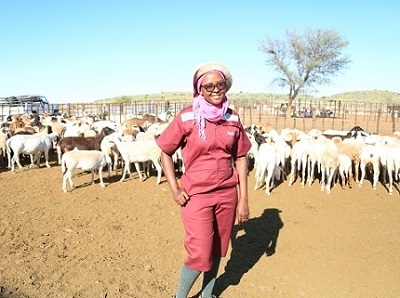Namibia is predominantly a meat (cattle, sheep, goat) producing country, and many farmers have been working hard to improve the genetics and performance of their livestock.
Yet the country’s performance in livestock production has been weak as a result of emerging farmers who lack the necessary skills and financial resources to acquire breeding materials and manage successful breeding programs.
This was said by Agribank’s technical adviser in livestock and rangeland Mr Erastus Ngaruka.
Ngaruka pointed out that some of the common challenges include the unaffordability of improved breeding stock (e.g. bulls, rams, bucks), unfavorable environmental conditions that compromise adaptability and performance, uncontrolled breeding activities, and lack of breeding information due to the absence of records.
“The main source of breeding materials are mainly farmers who specialize in stud breeding operations with a series of strict selection criteria for superior genetics in both large and smallstock,” Ngaruka stated.
“These breeding activities involve the use of animals of the same breed or use a combination of two or more different breeds to produce an offspring with desired traits or characteristics.”
Ngaruka explained that the two common breeding systems in livestock production are known as “straightbreeding” (pure breeding) and “crossbreeding” systems.
Straightbreeding is a practice of mating two parent animals of the same breed (e.g. Nguni x Nguni), while crossbreeding involves mating parents from two different breeds (e.g. Nguni x Brahman).
One of the advantages of “straightbreeding” is that it ensures continuity and uniformity of the characteristics of the breed. In addition, replacement breeding stock can be maintained within one herd or a flock.
“On the other hand,” Ngaruka pointed out, “‘crossbreeding’ strives for breed-complementarity by combining the desired traits or qualities from different breeds to achieve heterosis or hybrid vigor (enhanced performance in offspring).
“Furthermore, crossbreeding can produce pure breeds, known as composite or synthetic breeds. For example, a sheep breed such as the Meatmaster (Damara x Dorper), and cattle breeds such as the Bonsmara (Afrikaner x Hereford x Shorthorn) and Simbra (Brahman x Simmental) amongst others are composite breeds developed from crossbreeding systems.
“These breeding systems have sub-systems that some farmers adopt based on their breeding objectives, for example, inbreeding and linebreeding amongst others. These breeding practices can purposefully be used to mate closely or distantly related animals to retain specific traits within the herd or flock.”
However, Ngaruka points out that mating closely related animals continuously poses a higher risk of unveiling the least desirable traits in the offspring.
“For example, inbreeding in some cases is believed to result in stunted growths or abnormalities in progenies (offspring),” the animal expert said, adding that various livestock breeding systems have their advantages and disadvantages.
“However, the choice of any of the systems should be guided by the owner’s livestock improvement objectives, management abilities, and market or consumer demands.
“It is therefore advisable for farmers to identify traits that are of economic importance, identify genetic weaknesses in their herds or flocks that needs improvement, and thus, introduce breeding animals that can potentially correct their herd’s or flock’s genetics.”
In the photo: The young farmer Elize Eliphas posing in front of some of her livestock.







